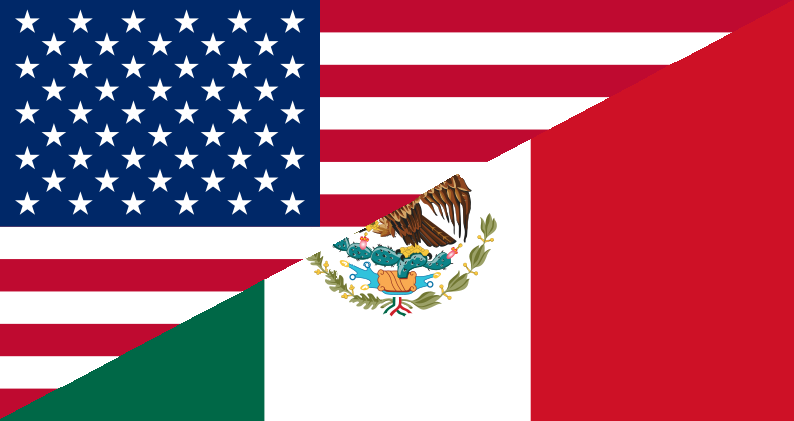Will Spanish Overtake English in America?
Would you believe us if we told you the United States is the fifth-largest Spanish-speaking country in the world?
Well, you better do!
According to a 2021 report by Statista, with more than 40 million native speakers, the US is currently ahead of Venezuela and Peru, and not very far from Spain! Add to this the millions of undocumented immigrants and the number of non-native Spanish speakers, and that number could easily rise to more than 60 million people, according to Instituto Cervantes, an organization that studies the status of Spanish around the world.
So, does this mean that Spanish will take over English in America? To better answer this question, let’s see what has happened with other languages.

Table of Contents
Photo by EHDI5YS via Wikipedia.
→Sign Up Now: Free Trial Spanish Lesson With a Native Speaker Teacher!←
A Look at the Past
Did you know that the largest ethnic group in the United States is not British, but German? If you didn’t, that’s because America’s largest minority has assimilated so well that Americans barely notice it.
So, when did the first large groups of German immigrants start to arrive? In the 1670s, a big number of German settlers came in with the British colonies, occupying territories in New York, Virginia, and Pennsylvania.
A few years later, between 1718 and 1750, France transported thousands of German immigrants from Europe to Louisiana, more specifically to Orleans, also known as the German Coast. From then on, immigration increased sharply, with more than seven million Germans arriving during the 19th century.
So, how come there are so few speakers of German in America nowadays? Apparently, it’s not a strange occurrence. Something similar happened to Italian. Between 1880 and 1900, there were millions of Italian immigrants who came to the US and, as you can imagine, all of them spoke Italian and only Italian.
However, their children, who spoke Italian with their parents at home, started to incorporate English from a very early age. By the mid 20th century, the third and fourth generations of Italian descendants knew just a few phrases in the language of their grandparents. Today, almost none of them speak Italian.
So, will Spanish overtake English in America, or will it go the same path as German and Italian?
Spanish in the US Today
Regardless of what the future of Spanish in America might be, one thing is undeniable. Right now, it is more popular than ever before. How did this happen? There are three main reasons why Spanish has become so widespread that many people are wondering whether Spanish could overtake English in America.
Immigration
The rise of Spanish in the US is mainly due to the influx of Spanish immigrants into the country, which seems to rise every year. The dominance of Spanish is not because the second and third generations of these immigrants are choosing to retain their own language, but because new waves of families whose only language is Spanish are arriving into the country all the time. However, as immigrants start to assimilate into the local culture, their children are more likely to drop Spanish as their main means of communication outside the family home and start to speak English.
As you can see, although increased immigration of Spanish-speakers means a lasting prevalence of the Spanish language in the US, the fact that immigrants’ descendants tend to assimilate into the English-speaking culture that surrounds them might prevent Spanish from overtaking English in America. At least for now.
Foreign Language Education
A few decades ago, it was not very common to find Spanish as a foreign language option in most school curriculums. French and German were the most popular choices. But due to the dominance of Spanish as the most widely spoken language in America, that has changed.
Plus, an ever-growing need for Spanish speakers in the workplace leads to more people wanting to understand Spanish at least at a conversational level, as they become more aware of the advantages that speaking Spanish brings about for their careers.
For this reason, most school districts nowadays offer at least one bilingual school option where some subjects are taught in both English and Spanish equally. Some places, like northern Virginia, have really committed to bilingualism and now provide a full Spanish-English bilingual program in all the area school districts.
Technology
For the last twenty years, technological advances have flooded the market for language studies, making learning more accessible and fun. From Netflix and audiobooks to learning apps and language-learning podcasts, there are all kinds of low-cost and even free resources right at people’s fingertips.
The great thing about these learning tools is that they have allowed busy learners to study at their own pace, often in short sessions during lunch breaks or even while they commute to work. This has resulted in an influx of Spanish learners that didn’t exist before…and has made the number of non-native Spanish speakers in the US ramp up at breakneck speed.
At the same time, streaming platforms like Amazon Prime and Hulu have helped Spanish media grow in popularity and accessibility to the extent that American audiences are starting to subscribe to streaming services depending on how much Spanish content they offer. This allows people to be immersed in the Spanish and Latin culture with a fun, relaxing activity, which in turn, encourages people to seek more formal learning experiences.
What Does the Future Hold for Spanish in the US?
Though it’s not likely that Spanish will overtake English in America any time soon, it is undeniable that Spanish holds a huge place in business and culture, and it will continue to do so. According to 2019 estimates by Instituto Cervantes, the United States is most likely to be the country with the second-largest number of native Spanish users by 2060, right after Mexico.
However, not everyone is so impressed by the status of Spanish in America. According to some, while Spanish has established a significant foothold as a foreign language in the States, it is still culturally and geographically marginalized, being spoken as a first language only in immigrant communities, small towns such as Toppenish, and some trailer parks outside of Yakima.
For these people, far from overtaking English in America, Spanish might end up in what they call the Language Graveyard for one simple reason. As we said before, languages almost never stay past the third generation after a family has relocated to the US.
In conclusion, though Spanish is not very likely to overtake English as the main language in America, it is clear that the influx of immigrants will help the language keep a strong presence as a second language all across the country. As a result, anyone who wants to get better job opportunities, bond with an ever-growing demographic or simply learn a useful skill, should see Spanish as an essential ability to have in the 21st century Even Forbes in this 2021 articlediscusses the growing importance of offering services in Spanish in the US.
→Sign Up Now: Free Trial Spanish Lesson With a Native Speaker Teacher!←
Do you want to study Spanish to stay ahead of the game and boost your job prospects? Would you like to take a course with a native speaker of Spanish who will be able to let you into their culture and share with you the reality of being a Spanish user in an English-speaking society? Contact us now and we’ll pair you up with a qualified Spanish tutor for a free trial lesson. Maybe, you can start by asking them what seems to be the most burning question: Will Spanish take over English in America?




